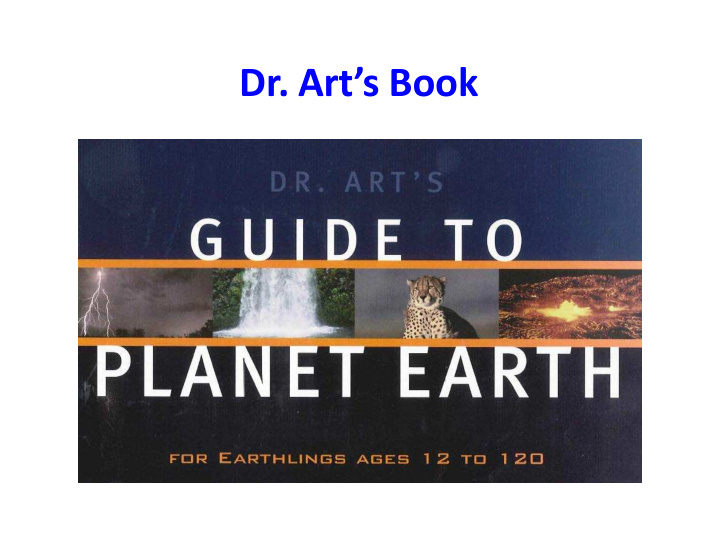



Dr. Art’s Book
Chapter 1
Literacy Strategies • A “Literacy Strategy” is a way to help yourself and your students to understand what you are reading. • “Interact With A Visual Image” is a literacy strategy that we used with the RMI Weather and Climate booklet. • Another literacy strategy is to look at the pages of a reading before starting to read it. • We will use this literacy strategy with Chapter 1 of Dr. Art’s Guide to Planet Earth
Looking at Chapter 1 • Just look at and briefly read some Section Titles , Big Ideas , and Drawings With A Text Box . • Talk with a partner about what you think you might learn in this chapter. • Write some words or ideas that you think you will be learning about in the chapter. • Be ready to share these words or ideas with the whole class.
Science Ideas Come in Different Sizes
AWESOME IDEAS TO FACTOIDS CONCEPT FACTOID AWESOME IDEA One or More Across All One DISCIPLINE TEACHING Rarely Some; Often Vocabulary TESTING Rarely Some; Often Vocabulary We want to move teaching, learning and testing away from mostly memorizing vocabulary toward more understanding of big ideas.
Systems in Current Science Education • Body systems : circulatory system, nervous system, immune system, skeletal system, etc • Ecosystems • Earth systems : atmosphere, hydrosphere, geosphere, biosphere • Whole Earth system : Earth system science
Systems within Systems within Systems
Water has properties that are QUALITATIVELY different than those of its parts.
Important Features of Systems • Systems are made of parts that connect with each other. • Each part of a system can itself be described as a system. (“Systems within systems within systems.”) • A system can have properties that are very different than those of its parts. (“System Properties”)
Systems are made of parts that are themselves systems made of parts. Systems have qualitatively different properties. SYSTEMS
Systems Can Make a Planet
Three Parts of the Earth System • Earth’s Matter • Earth’s Energy • Earth’s Life
Earth is Essentially a Closed System for Matter
Earth is an Open System with Respect to Energy
Earth is a Networked System with Respect to Life
Earth’s Global Temperature Earth’s global temperature is a property of the whole Earth system. Earth’s global temperature arises from the interactions of all of Earth’s parts with each other and with the incoming sunlight.
Begin to Draw A System: Part 1 • Start with a partner to draw a system. The system can be a school, taro patch or village. • Keep the drawing simple. This Part 1 is to help you begin to get your ideas on paper. • Include and label the parts of your system. • Include in the drawing what goes into your system (inputs) • Include in the drawing what goes out of your system (outputs)
Heat Energy Sunlight Out Energy In Sunlight Carbon Heat Oxygen In Water In Energy In Dioxide Out Water Out Energy Out Oxygen Out Carbon Electric Dioxide In Energy In Waste Out Food In Garbage Out Some System Properties: A Happy Family; Energy Efficiency A Home and Garden System or Carbon Footprint of Home
Draw a System: Part 2 • Join with another pair of people who have worked on the same system as you • Look at the home/garden system model – On chart paper, make a new large drawing of your system that you will share with the whole class – Indicate at least one place where a part of the system interacts with another part of the system – Write at least one property of the whole system that is different than the properties of its parts
Recommend
More recommend